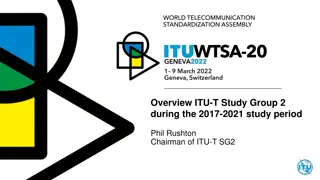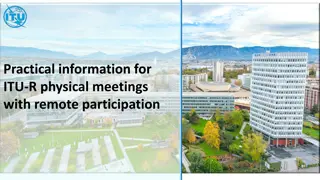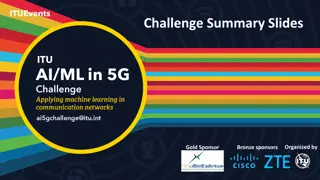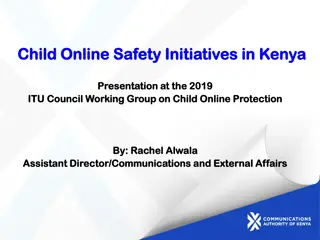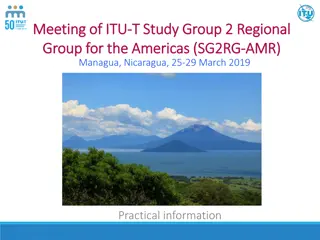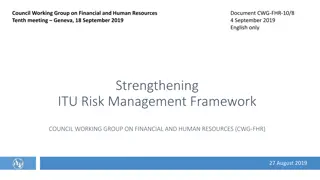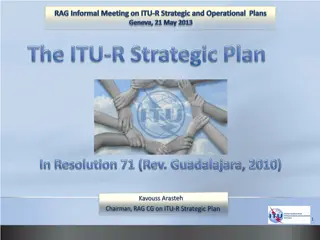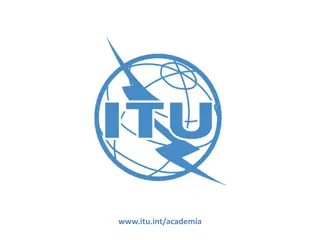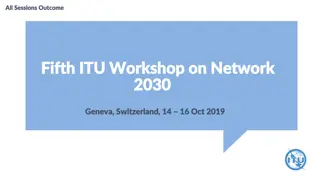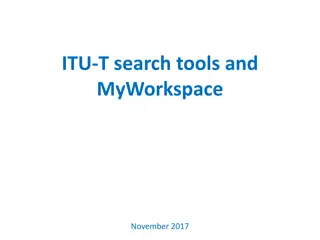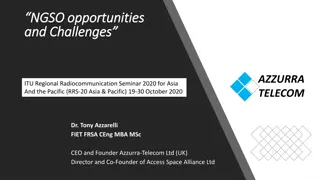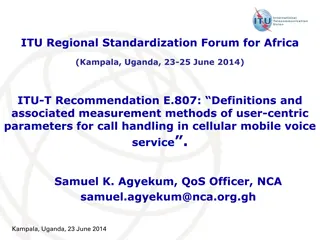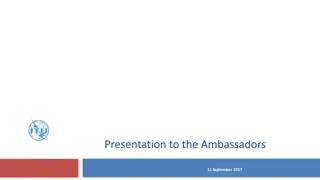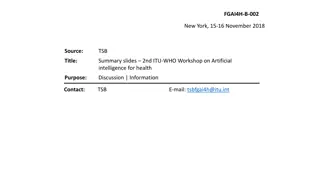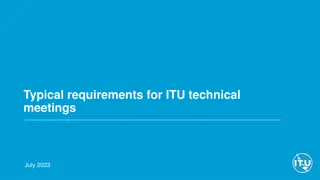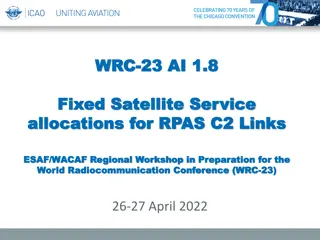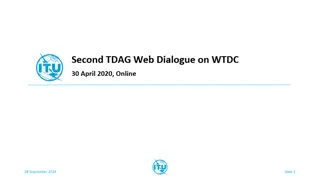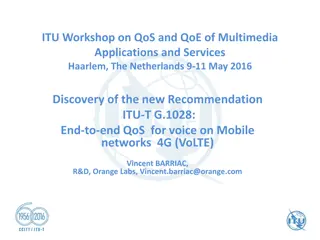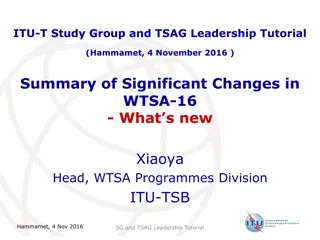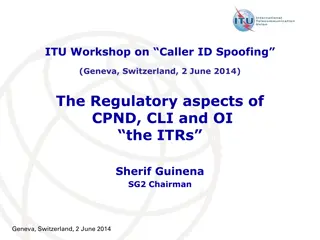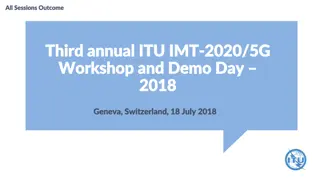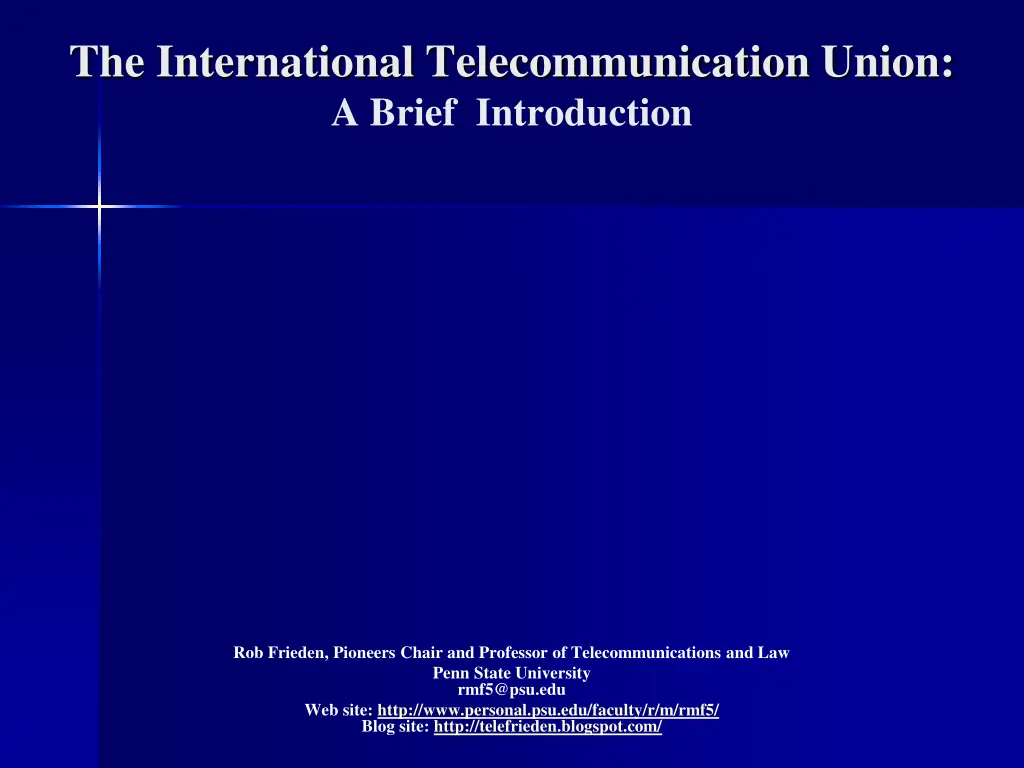
ITU Spectrum Planning: Importance and Challenges
Explore the intricate processes of spectrum planning at the International Telecommunication Union (ITU) and its impact on global telecommunications. Learn about the core principles of technological optimization, trust building, and consensus building crucial for harmonization in spectrum allocation. Discover how the ITU navigates tensions surrounding trade, security, and market advantages while striving for legitimacy and compromise. Gain insights into the world radio conferences and their significance in shaping the future of communication technologies.
Download Presentation

Please find below an Image/Link to download the presentation.
The content on the website is provided AS IS for your information and personal use only. It may not be sold, licensed, or shared on other websites without obtaining consent from the author. If you encounter any issues during the download, it is possible that the publisher has removed the file from their server.
You are allowed to download the files provided on this website for personal or commercial use, subject to the condition that they are used lawfully. All files are the property of their respective owners.
The content on the website is provided AS IS for your information and personal use only. It may not be sold, licensed, or shared on other websites without obtaining consent from the author.
E N D
Presentation Transcript
The International Telecommunication Union: A Brief Introduction Rob Frieden, Pioneers Chair and Professor of Telecommunications and Law Penn State University rmf5@psu.edu Web site: http://www.personal.psu.edu/faculty/r/m/rmf5/ Blog site: http://telefrieden.blogspot.com/
The Main Points Spectrum planning at the ITU constitutes a tedious and incremental process designed to emphasize study, consensus and trust building, and conflict avoidance at the expense of timeliness. Typically, the ITU process precedes domestic spectrum allocation and assignments. However, motivations to expedite large additional frequency allocations for 5G services (and $ billions in auction revenues) have prompted the United States and other nations to act unilaterally and before completion of the ITU process. Returning to core principles of technological optimization, trust building, harmonization, planning and consensus building can foreclose the risk of further challenges to ITU legitimacy and its ability to forge compromise despite rising tensions about trade, national security and first mover market advantages. 2
ITU Spectrum Planning in a Nutshell The ITU is the oldest, continuously operating inter-governmental organization, operating since 1875. Now a specialized agency of the U.N., it seeks to build consensus in spectrum allocations, technical standards and ICT4D. While some national commitments have treaty-level status, much of what the ITU does lies in non-binding, but consensus driven recommendations that most nations accept and implement. Positive network externalities favor shared standards, uniform rules of the road conflict avoidance and resolution supporting single global product lines, fewer incompatible frequency assignments and tech standards. Spectrum planning is a time consuming, methodical process involving: 1) development of an agenda of new allocations and reallocations, first subject to study and analysis; 2) opportunities for national delegations to articulate their position; 3) consensus building and development of national commitments, to reduce the number of non-conforming footnotes to specific spectrum allocations by individual nations; 4) formal designation of frequency allocations for one or more specific services by the ITU and individual nations; and 5) the eventual registration of radio spectrum uses and satellite orbital locations by the ITU. 3
World Radio Conferences Core Agenda Each World Radiocommunication Conference affects the future development of information and communication technologies (ICTs) in many ways, including: Introducing and expanding access to the radio spectrum for new radiocommunication systems and applications; Protecting the operation of existing radiocommunication services and providing the stable and predictable regulatory environment needed for future investments; Avoiding the potential for harmful interference between radio services; Allowing the provision of high-quality radiocommunications while protecting vital uses of the radio spectrum, particularly for distress and safety communications; and Facilitating international roaming and increasing economies of scale, thereby making it possible for network and user devices to be more affordable (Maniewicz, (2019 Dec. 2). 4
Challenges to the ITUs Legitimacy and Relevancy Increasing dissatisfaction with the pace of progress by inter-governmental agreements instead of market forces operating on Internet time. Real or perceived mission creep by ITU senior management to expand the agency s wingspan and mission while also accommodating initiatives of some nations (Russia, China, Iran, Cuba) to assert sovereignty and limit Internet freedoms. The 2012 World Conference on International Telecommunication (WICT-12) had an unusual and controversial vote favoring a direct role for the ITU to include Internet governance in its treaty-specified mission, possibly including cybersecurity. 5
A Study in Frustration and Misunderstanding There is a real possibility that these practices undermined the value of future WRCs and increased the risk that the ITU will become a tool for governments and incumbent spectrum users to halt spectral efficiency and technological progress. Global spectrum harmonization for future services will be difficult, if not impossible, or, at a minimum, be years behind innovation if such practices are allowed to occur. At the same time, global technological leaders, such as the U.S., will continue to innovate outside and without input from the ITU and its many nation states. This will, in turn, make the ITU and the WRC process less relevant (FCC Commissioner Michael O Rielly, 2016). Unlike some countries, we do not believe we should spend the next couple of years studying what 5G should be, how it should operate, and how to allocate spectrum, based on those assumptions. Like the examples I gave earlier, the future has a way of inventing itself. Turning innovators loose is far preferable to expecting committees and regulators to define the future (FCC Chairman Thomas Wheeler, 2016). We won t wait for the standards to be first developed in the sometimes arduous standards- setting process or in a government-led activity. Instead, we will make ample spectrum available and then rely on a private sector-led process for producing technical standards best suited for those frequencies and use cases. Leadership in networks leads to leadership in uses, which quickly moves across borders. A result of this national leadership is the creation of a home-field advantage, similar to what we experienced with 4G (Wheeler, 2016). 6
WRC-19 Major Spectrum Allocations WRC-19 s agenda included the following diverse spectrum applications: Earth exploration-satellite (EESS) service Recommending establishment of a worldwide primary allocation 22.55-23.15 GHz for tracking, telemetry, and network control of satellites providing remote sensing of earth and atmospheric factors such as temperature and water vapor; Non-Geostationary Satellites Formulating regulatory procedures for registering non-geostationary satellite constellations launched to provide fixed, instead of mobile services. Low earth orbiting satellites constellations, numbering in the hundreds or more, can provide globally a variety of services including telecommunications, remote sensing, space, and upper atmosphere research, meteorology and astronomy; High-altitude platform stations (HAPS) Allocating spectrum for telecommunications and information services via blimps and other slow moving vehicles located in the stratosphere; 7
WRC-19 Major Spectrum Allocations (cont.) Railway radiocommunication systems between train and trackside (RSTT) Facilitating the deployment of railway train and trackside systems to support improved railway traffic control, passenger safety, and security; Intelligent Transport Systems (ITS) Recommending the integration of information processing and telecommunications technologies for management of vehicular traffic including self-driving cars; Broadcasting-satellite service (BSS) Recommending the establishment of a priority access mechanism for developing countries to secure satellite orbital slots for audio and video services delivered via satellite; and Global Maritime Distress and Safety System (GMDSS) Expanding spectrum allocated for maritime safety and emergency services (ITU News Magazine, No. 6, 2019). 8
Winners at WRC-19 Both incumbents and newcomers willing to work within known constraints in longstanding international rules of the road. Stakeholders willing to play the long game, e.g., low earth orbiting ( LEO ) satellite carriers, recognized as a new type of fixed satellite service provider, separate from legacy providers operating in geostationary ( GEO ) orbits 22,300 miles above earth. Recognized the Internet of Things, a large array of sensors, devices and other types of equipment providing infrastructure for the information society (ITU, 2017a). WRC-19 allocated a large swarth of spectrum at extremely high frequencies optimized for short distance, low latency links that Internet sensors and devices will use. Manufacturers of chip sets may have enhanced opportunities for installation of multiple components to handle millimeter wave guide, below 6GHz and existing UHF spectrum allocated for 5G New, or existing spectrum users allocated initial, or additional bandwidth, e.g., Wi-Fi, intelligent highways, earth exploration, high-altitude platform stations, railroads, broadcast satellite services, maritime distress and safety. 9
Losers and Mixed Outcomes at WRC-19 Nations, like the U.S., have to share leadership with other nations and cannot expect to have their agenda adopted with little coordination and advocacy. Incumbent and future C-band satellite users, in having to negotiate with LEO operators and likely losing priority access to a portion of the frequency band. UHF broadcasters, keen on repacking compensation will have to wait until WRC-23; others get a beneficial delay in having to share, possibly without additional compensation forthcoming. Wireless consumers not likely to have a single, global handset able to access all 5G domestic frequency allocations. 10
Conclusions and Recommendations Go it alone unilateralism at WRCs has both significant upsides and downsides. The balance of power has shifted from the U.S., E.U. and Japan to a larger set of nations, each having an equal vote at the ITU, as well as increasing NGOs including, manufacturers of IOT and autonomous vehicles, fintech, smart cities, e-health, etc. Do not forget the lessons from WSIS-12 where on an 89-53 vote the majority favored revision of the treaty-level International Telecommunications Regulations to include Internet governance and access control by individual nations. Reemphasize best practices, including pre-conference, consensus building within the U.S. delegation and regional forums, such as CITEL. Tread lightly, if at all, on extraneous matters such as 5G global technology leadership and questionable concerns about espionage. Lower expectations and rhetoric. 11

